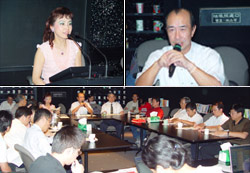
2005年9月18日下午,雖然適逢中秋佳節月圓人團圓的節日,大部分的考察團員還是特地撥空前來祐生蟲洞參與行前說明會。會中,林俊興董事長再次申明祐生此次參加2005年永續建築國際會議之角色與定位,亦即以非政府組織(NGO)的方式參與,而祐生此次在大會中所發表之論文,大部分都環繞在闡述共生生態環結構、共生圈一號中已實際落實到可操作層面之理論等。接著黃晉英秘書長也向大家詳盡說明行程的特色、重點以及需要特別留意的事項。最後,林俊興董事長也為此次的活動定調,與其在SB2005會議中僅做階段性之論文報告,不如俟時機成熟一舉讓國際驚豔,因此本次SB2005將以參加一般國際性會議的心態輕鬆面對。
Though September 18, 2005, was the Mid-Autumn Festival, the festival for family reunion, most delegates still came to the Archilife Wormhole in the afternoon for the SB05 departure briefing. At the beginning of the briefing, President Lin Chun-shin restated the foundation role and position at the SB05Tokyo; i.e. we participated in the event as a non-government organization (NGO). In fact, most papers presented at the conference were about the structure of the Symbiotic Ecological Environment, and the operable theories of the Symbiosphere 1 Center. Then, Secretary General Huang Chin-ying explained in detail the characteristics, foci and reminders of the trip. Lastly, President Lin Chun-shin set the tone of the event: Instead of presenting procedural papers at the SB2005, we should shock the world with one single strike at the right moment. Therefore, we would participate in the SB2005 like attending other general international conferences.

2005年9月22日下午,考察團員按原訂計畫於祐生蟲洞及桃園中正機場第二航站中華航空櫃台等集合。登機前,林俊興董事長特地前來為大家送行,表達期望團員們於SB2005會議期間,將台灣永續建築相關經驗傳播出去,並祝福此次行程一切順利。帶著林俊興董事長的期望與祝福,團員們依序通關,啟程出發到日本。在歷經前後六小時的飛行及車程,考察團一行於晚間10點左右抵達當天預定下榻的太平洋飯店,在稍事休息後,部分初到異地、興奮難掩的團員們在黃晉英秘書長與王文安先生的嚮導下,興致勃勃地前往飯店附近探訪品川火車站及品川 Inter City都市更新區的建設。品川為東京市都會區南側一重要交通轉運之衛星城市,2003年秋天東海新幹線站開業,品川更成為便利的東京玄關口,負責轉運東京各地至橫濱及羽田機場方向的旅客與貨物。處於再開發中的東京,品川也是經歷過再開發過程,完成後大為改觀的城市,品川Inter City都市更新區於規劃時即考慮到降低建蔽率,增加空地綠覆率,此外於建築設計及配置上亦考慮到植物所需之陽光照射,將建築物儘量配置於北向或避免植物陽光照射不足之位置,整區經周詳的規劃,呈現出一整齊大方的都市商業及辦公用途都市區域。

In the afternoon of September 22, 2005, delegates met at the Archilife Wormhole and the China Airlines counter at Terminal 2 of the CKS International Airport as planned. President Lin Chun-shin specially came to bid farewell to everybody before boarding, hoping that delegates could spread the sustainable building experiences of Taiwan to the whole world and wishing us well. With the wishes and blessings of President Lin Chun-shin, delegates completed the immigration check one after another and set off on the journey to Japan. After traveling for 6 hours in the air and on the ground, the delegation arrived at the Pacific Hotel at around 10:00 pm. After a short rest, some delegates who were visiting Japan for the first time were so excited that they asked Secretary General Huang Chin-ying and Mr. Wang Wen-an to take them to visit the Shinagawa Station and buildings in the Shinagawa Inter City after the urban renewal in the nearby neighborhood. Shinagawa is an important satellite city serving as a transportation hub in the south of the Tokyo metropolitan area. After the Tokaido Shinkansen Station started operation in the autumn of 2003, the city even became the vestibule of Tokyo. In fact, it is the passenger and cargo entrepot between Tokyo and Yokohama and the Haneda Airport. Located within the territory of the redeveloping Tokyo, Shinagawa also experienced urban renewal. Right at the beginning of planning, the reduction of building coverage has been considered in the urban renewal area-Shinagawa Inter City, in order to increase the green coverage in the open. Additionally, sunlight irradiation required by plants was also considered in the design and layout of buildings. Therefore, most buildings were laid in the north or locations where plants could receive adequate sunlight. After detailed planning, the entire area was turned into a well-laid business and office urban area.